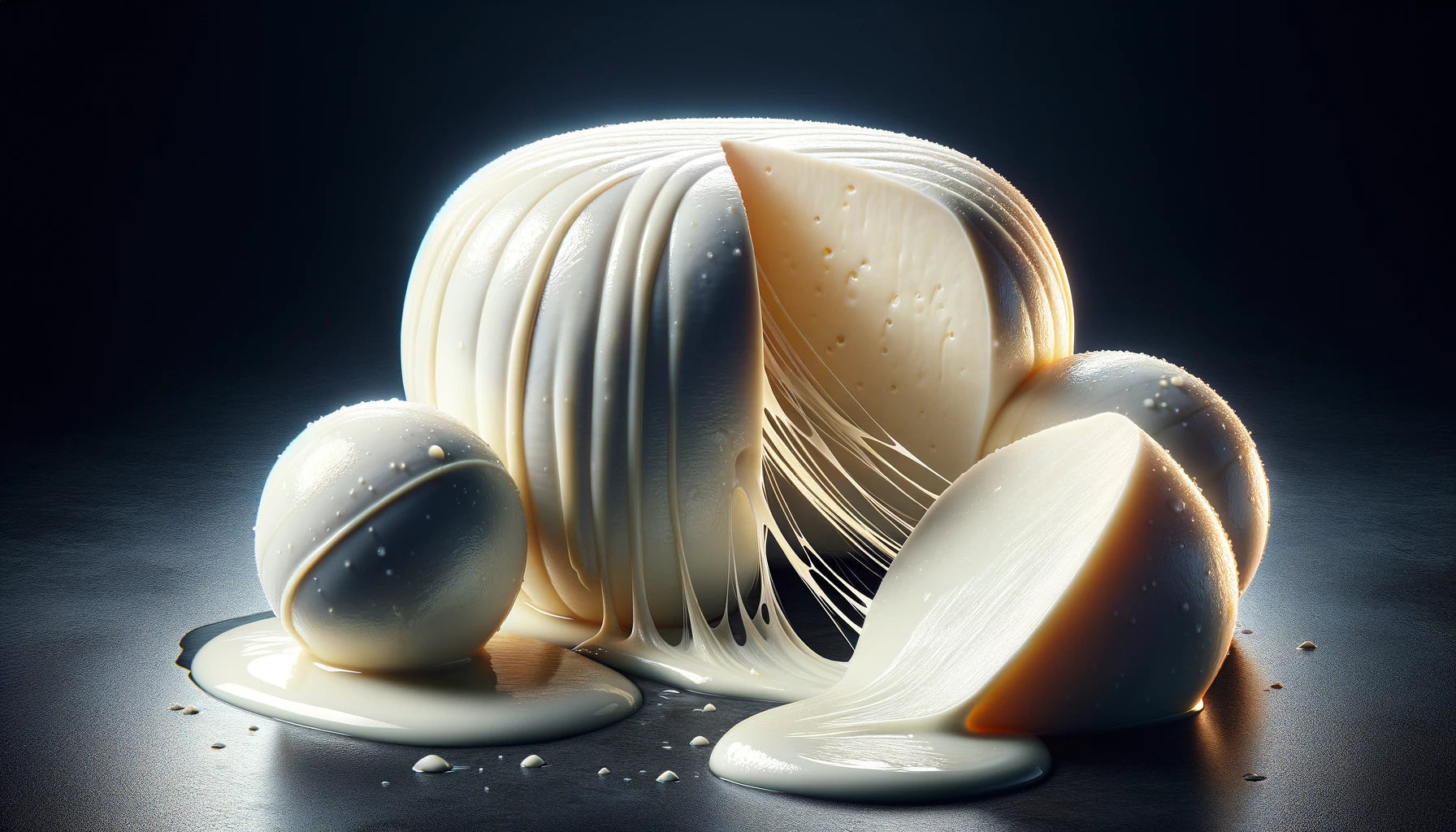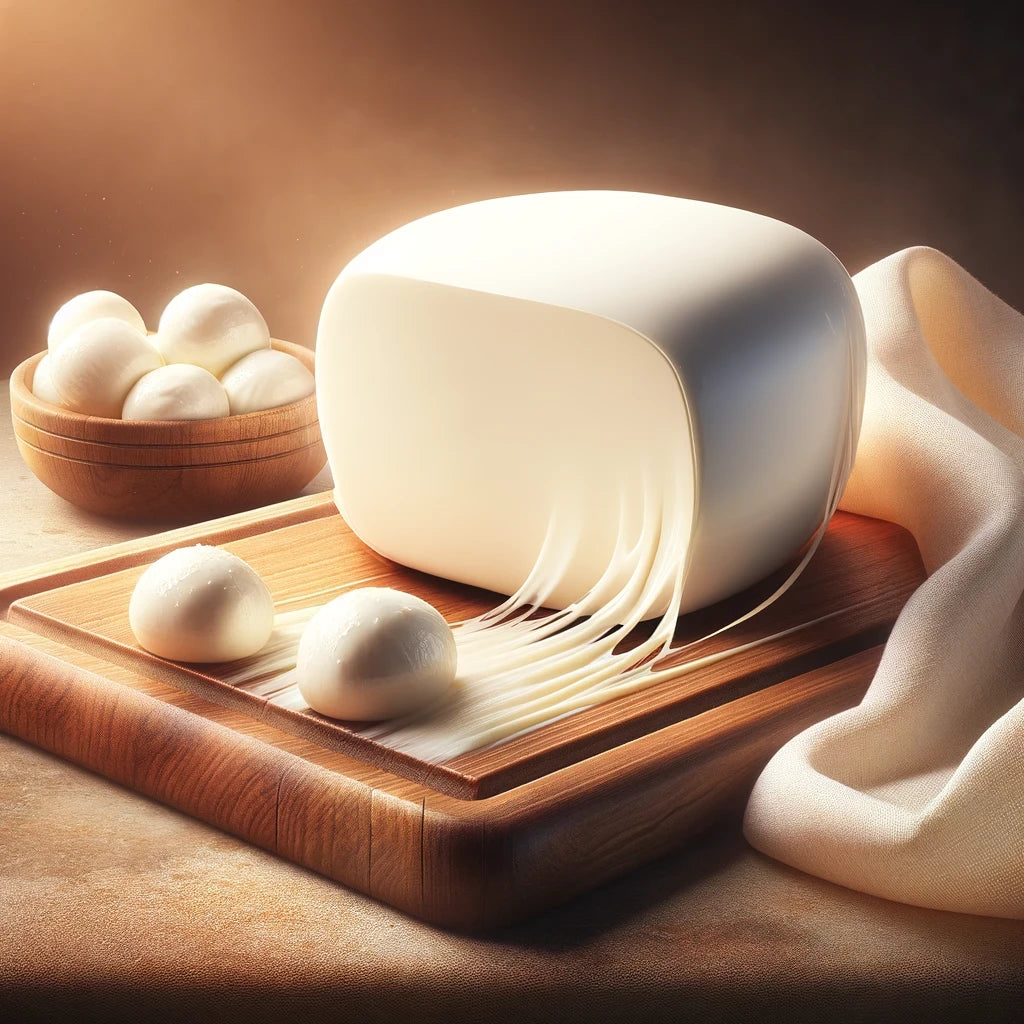Mozzarella Mastery: Cheese Making from Milk to Curd
Key Takeaways
- Quality of Milk is Paramount: The type of milk used significantly influences the flavor, texture, and overall quality of the mozzarella. Traditional mozzarella is made from buffalo or cow's milk, but alternatives like goat's milk can also be used, each adding a unique taste profile.
- Precision in Temperature Control: Accurate temperature control throughout the cheese-making process is vital for achieving the desired consistency and quality of the mozzarella.
- Art of Stretching: The stretching or pulling of the curd is what gives Mozzarella Cheese its characteristic texture. This step is essential for creating the cheese’s signature stretchiness and smoothness.
- Exploration of Science in Cooking: The process of making mozzarella at home is an excellent example of applied science, involving chemistry, biology, and physics to transform milk into cheese.
- Historical and Cultural Significance: Mozzarella cheese has a rich history that traces back to Italy, reflecting the evolution of cheese-making techniques and the cultural significance of food preservation practices.
The Science of Mozzarella Cheese Making
The creation of mozzarella cheese from milk is a testament to the ingenuity of traditional food preservation and fermentation techniques. The process begins with high-quality milk, which can be from cows, goats, or even buffalo, each imparting its unique flavor profile to the cheese. The transformation of liquid milk into the solid form of cheese involves several critical steps and ingredients, including the introduction of citric acid and rennet.
Citric acid plays a pivotal role in acidifying the milk, setting the stage for the milk proteins, particularly casein, to coagulate. Rennet, an enzyme complex traditionally derived from the stomachs of ruminant animals, further encourages this coagulation, causing the milk to separate into solid curds and liquid whey. It's this separation that lays the foundation for mozzarella cheese, with the curds undergoing additional processing to achieve the cheese's characteristic texture.
Inoculation and Curdling
The journey from milk to cheese is a marvel of microbial activity. The inoculation of milk with lactic-acid-producing bacteria initiates the fermentation process, transforming lactose (milk sugar) into lactic acid. This acidification process enhances the milk's ability to coagulate when rennet is added. The quality of milk is paramount here; it must be free from antibiotics and other inhibitors that could affect the growth of these beneficial bacteria.
Cutting the curd and cooking it at precise temperatures are critical steps that impact the moisture content and texture of the final cheese. After curding, the Mozzarella Cheese undergoes a unique process known as stretching or pulling, giving it the distinct texture that is both firm and delightfully chewy.

Historical Journey of Mozzarella
The art of cheese making dates back thousands of years, with origins traced to the Middle East before spreading across the Roman Empire and into Europe. The process and varieties of cheese evolved significantly over the centuries, influenced by local climates, cultures, and technological advancements. Mozzarella itself is deeply rooted in Italian tradition, initially made from water buffalo milk in the regions of Campania and Lazio.
As cheese making transitioned from an art to a science, the ability to replicate and refine the cheese-making process improved, leading to the diverse array of cheese varieties we enjoy today. Mozzarella, with its simple ingredients and relatively straightforward process, became a staple in Italian cuisine and a favorite across the globe for its versatility and mild, creamy taste.
Step-by-Step Guide to Making Mozzarella at Home
Making mozzarella at home is an achievable endeavor for any cheese enthusiast, offering a window into the ancient art of cheese making. Here's a simplified guide to creating your own mozzarella, emphasizing the importance of ingredient quality and precision in the process:
- Preparing the Ingredients: Start with high-quality milk. Avoid ultra-pasteurized milk as it won't coagulate properly. Mix water with citric acid until dissolved, and in a separate bowl, do the same with rennet.
- Warming the Milk: Heat the milk gently and stir in the citric acid solution. Once the milk reaches the right temperature, add the rennet solution, stirring gently to distribute it evenly.
- Curdling and Cutting: After a brief rest, the milk will coagulate, forming a gel-like consistency. Cut this curd into uniform pieces, allowing the whey to start separating.
- Stretching the Curd: Perhaps the most iconic step in making mozzarella is the stretching. Heat the curds in hot water until they become elastic, then knead and stretch until the cheese achieves its characteristic smooth, shiny texture.
- Salting and Shaping: Add salt to taste during the final stretches. Shape the cheese into balls or braids, then cool in a brine solution or fresh water to firm up.
Variations for Dietary Preferences
As dietary preferences evolve, so does the world of cheese making. For those seeking dairy-free alternatives, Vegan Cheese made from Cashew Butter or other plant based cheese offer a similar texture and flavor profile, using ingredients like nutritional yeast for a cheesy umami flavor, and agar or tapioca for stretchiness.
Whether you're a traditionalist devoted to the craft of dairy-based mozzarella or a modern culinary explorer experimenting with Vegan products like vegan butter, fat free cheese, or Unsalted Butter, the process of cheese making opens up a realm of creativity and connection to food's rich history. Through understanding the science behind the transformation of milk into cheese, embracing the artistry of shaping and flavoring your creations, and exploring the vast array of ingredients available today, anyone can embark on this delicious journey from milk to mozzarella.
Making mozzarella at home not only demystifies the process of cheese making but also offers a deeply satisfying sense of accomplishment. Whether you're stretching a ball of dairy mozzarella to perfection or experimenting with vegan cheese alternatives, the magic of transforming simple ingredients into a delectable culinary masterpiece is an experience worth savoring.
The Enigmatic Science Behind Mozzarella Cheese
The alchemy of turning milk into mozzarella is a ballet of biological and chemical processes. Central to this transformation is the quality of milk, which influences not just the flavor but the texture and integrity of the cheese. Traditional mozzarella is crafted from the milk of water buffalo (Mozzarella di Bufala) or cows, with each type imparting unique characteristics to the final product.
Ingredients and Process
- Citric Acid: This acts as a milk acidifier, altering the milk's pH and setting the stage for coagulation.
- Rennet: A complex of enzymes, rennet is pivotal for coagulating the milk, separating it into curds and whey. The curds, rich in fats and proteins, are the foundation of the cheese.
- Temperature Control: Precise heating and cooling at various stages are crucial for achieving the desired consistency and flavor profile of the cheese.
The cheese-making process can be summarized into key stages: milk preparation, curdling by the addition of citric acid and rennet, curd cutting and whey separation, curd kneading and stretching, and finally, shaping and storing the cheese. Each step is a testament to the cheese maker's skill and understanding of the subtle interplay between ingredients and conditions.
A Glimpse into Mozzarella's Past
Mozzarella's history is as rich and layered as its flavors, tracing back to the pastoral landscapes of Italy. However, the art of cheese making predates even these venerable origins, with roots reaching back to the domestication of milk-producing animals in the Middle East. As cheese making spread through Europe, it evolved through the Middle Ages into the Renaissance, diversifying into the myriad forms we recognize today.
Mozzarella, specifically, with its origins in the lush regions of Campania, became a staple of Italian cuisine, its production a carefully guarded art passed down through generations. The advent of scientific understanding in the 19th and 20th centuries transformed cheese making from an art into a precise science, enabling the consistent production of mozzarella and other cheeses on a global scale.

Crafting Mozzarella at Home: A Step-by-Step Guide
Making mozzarella at home is an accessible joy, a process that rewards patience and precision with fresh, delicious cheese. Here’s how you can embark on this culinary adventure:
- Starting with the Milk: Choose high-quality, preferably organic milk. The milk's origin (cow, goat, or buffalo) will impart distinct flavors and textures to your cheese.
- Acidification: Dissolve citric acid in water and add it to the milk. This lowers the pH, preparing the milk for coagulation.
- Adding Rennet: The addition of rennet is a critical moment, transforming the liquid milk into a solid mass of curd and whey.
- Curd Cutting: Once coagulated, the curd is cut into smaller pieces, a step that determines the moisture content of the cheese.
- Stretching the Curd: Perhaps the most iconic step, the curds are heated and then stretched, folded, and kneaded into the smooth, shiny texture characteristic of mozzarella.
- Shaping and Storing: Form the cheese into balls or braids, then store in a brine solution to maintain its moisture and freshness.
Embracing Modern Diets: Vegan and Plant-Based Alternatives
The growing demand for vegan and plant-based dietary options has led to the development of mozzarella alternatives that eschew animal products without compromising on taste or texture. Ingredients such as cashew nuts, coconut oil, and various binding agents mimic the creamy consistency and flavor profile of traditional mozzarella, offering a sustainable and ethical choice for those abstaining from animal products.
Mozzarella: Beyond the Cheese
Mozzarella's journey from milk to cheese is a narrative woven through time, a culinary practice that mirrors the evolution of human society itself. Whether indulging in the rich history of traditional mozzarella or exploring the innovative realms of vegan cheese, the process of making mozzarella at home is a deeply rewarding experience that connects us to the essence of food as both nourishment and art.
The adventure of creating mozzarella, be it through time-honored methods or modern adaptations, is a testament to the enduring allure of cheese making. It’s an invitation to explore the complexities of flavor, the nuances of technique, and the satisfaction of crafting something truly exquisite from simple, humble beginnings. Whether draped atop a savory pizza or nestled within a vibrant caprese salad, mozzarella cheese—in all its forms—continues to captivate and delight palates across the globe.








